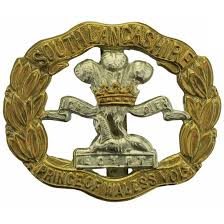Personal Details
Born: 12 December 1884 in Stockwell, London.
Family: No record of him can definitely be found until the 1911 Census which shows him living with his wife Margaret E Bird, who was born in Ellesmere, Shropshire and who he married in 1909 in Battle, Sussex.
Residence: On the 1911 Census he was living at Liverpool Street, Whitchurch, Shropshire. By the time of the 1939 Register the couple had moved to 17 Cullard Street, Crewe, Cheshire. This was the address given at the time of his death in 1955.
Employment: In 1911 his occupation was given as a van driver for a laundry. On the 1939 Register he was working as a bus driver for the Crosville Company.
Died: In Crewe Memorial Hospital on 14 February 1955, aged 70.
Military Details
Regiment: South Lancashire Regiment (previously King’s Shropshire Light Infantry)
Rank: Private
Service Number: 34625 (previously 21368)
Date of Enlistment: Not known
Date of Discharge: Not known
Reason for Discharge: Not known
Ernest was awarded the Campaign Medals (British War Medal and Victory Medal).

The British War Medal (also known as 'Squeak') was a silver or bronze medal awarded to officers and men of the British and Imperial Forces who either entered a theatre of war or entered service overseas between 5th August 1914 and 11th November 1918 inclusive. This was later extended to services in Russia, Siberia and some other areas in 1919 and 1920. Approximately 6.5 million British War Medals were issued. Approximately 6.4 million of these were the silver versions of this medal. Around 110,000 of a bronze version were issued mainly to Chinese, Maltese and Indian Labour Corps. The front (obv or obverse) of the medal depicts the head of George V. The recipient's service number, rank, name and unit was impressed on the rim.
The Allied Victory Medal (also known as 'Wilfred') was issued by each of the allies. It was decided that each of the allies should each issue their own bronze victory medal with a similar design, similar equivalent wording and identical ribbon. The British medal was designed by W. McMillan. The front depicts a winged classical figure representing victory. Approximately 5.7 million victory medals were issued. Interestingly, eligibility for this medal was more restrictive and not everyone who received the British War Medal ('Squeak') also received the Victory Medal ('Wilfred'). However, in general, all recipients of 'Wilfred' also received 'Squeak' and all recipients of The 1914 Star or The 1914/1915 Star (also known as 'Pip') also received both 'Squeak' and 'Wilfred'. The recipient's service number, rank, name and unit was impressed on the rim.

